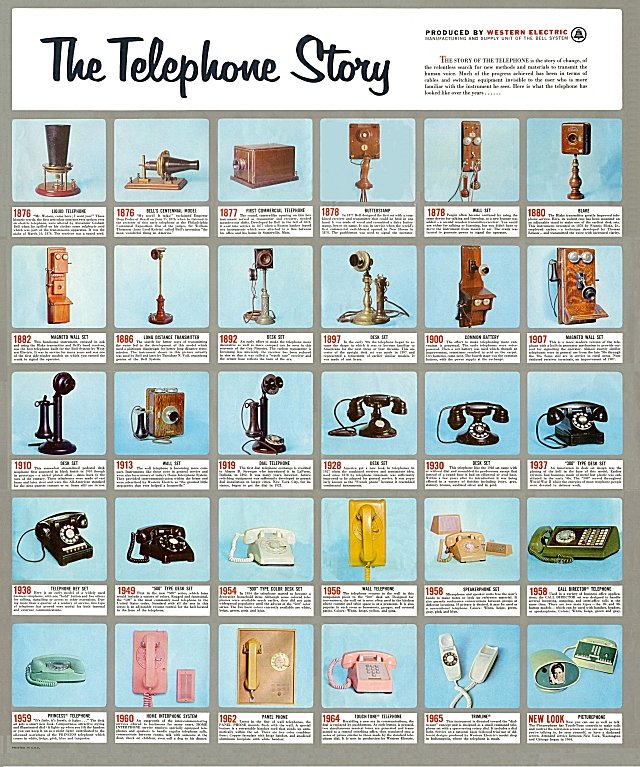Telephone Models
Here are just a few examples of antique telephone models from the United States. Many of the earlier models shown here can be difficult to find for sale (and are often quite expensive), but models made during the 1900s are easier to find. You will find many more models by visiting the links within the History, Collecting & D.I.Y. section of this site, and on the retail sites I have linked at the bottom of this page.
1877-1878
Bell Telephone Company / Charles Williams, Jr. “Coffin” Telephone. The Boston firm of Charles Williams, Jr., where Alexander Graham Bell had initiated his development of the telephone, became his first exclusive phone manufacturer. This model was used by many early telephone subscribers in the Boston area. It included one sound handset with both a transmitter and receiver. The magneto cranks on the front was used for signaling the operator or other directly-connected telephones.
As users found it difficult to move the handset back and forth between their ear and mouth, Williams produced an updated version with two handsets – one for listening and one for speaking.
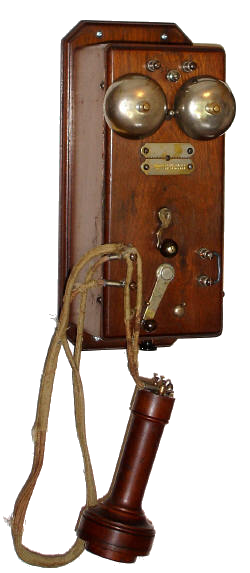
1880
American Bell Telephone / Charles Williams, Jr. Three Box Telephone. This model resulted from Bell’s brief competition from the Western Union Telegraph Company, which had produced telephones with superior sound quality in the late 1870s. As Bell won his patent infringement suit against Western Union, he was able to use some of their innovations. The Berliner-Blake microphone used in this new model was based on the carbon transmitter invented by Thomas Edison for Western Union. The bottom compartment held the wet cell battery needed to power long distance calling, and the top ringer box included a magneto crank on the right. The company also produced similar models in which the microphone box and battery portion were mounted separately on the wall.
Many of these models were later modified for better long-distance calling with a new “solid back” microphone (invented by Anthony C. White) that replaced the Blake transmitter in 1890.

1890s
American Bell Telephone / Western Electric Magneto “Three Jug” or Long Distance Telephone. Anticipating new competition once the Bell phone patents would expire in 1895, The American Bell Telephone Company began introducing several new models like this one in the early 1890s. Bell had formed an exclusive partnership with Western Electric to manufacture its telephones in 1882. This particular model included the new solid back transmitter and a wider compartment at the base to accommodate three batteries (instead of the usual two), providing enough power to make long-distance calls.

1890s / Early 1900s
American Bell Telephone / Western Electric Nickel Candlestick. Candlestick models were too small to hold a ringer and all of the parts necessary to function, so they were always connected to a separate ringer box or subscriber set made of wood, metal or (later) plastic. Unlike the Strowger dial phone below, this model was deployed for many Bell system companies and required a live operator’s assistance to initiate a call. Nickel and brass-plated versions gradually morphed into a popular black-finish model that was eventually made of steel. This model is more streamlined than earlier models that featured a pot-belied shaft, and probably dates from the first decade of the 1900s.
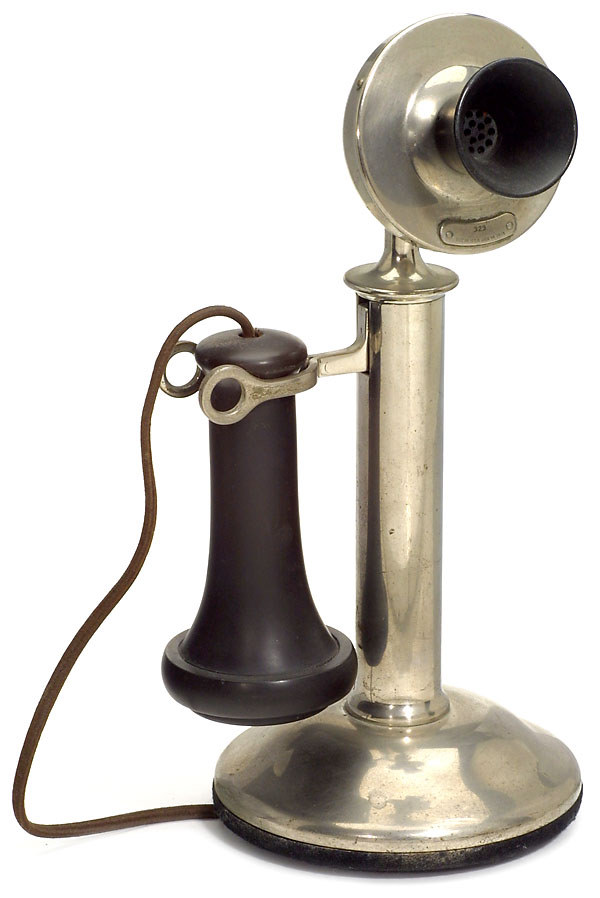
Early 1900s
American Bell Telephone / Western Electric Oak Wall Phone with Magneto crank. The model shown here dates from 1907 or later, when the receiver terminals were first hidden inside the cabinet. Many rural areas required use of a magneto crank and battery to generate the current needed to summon the operator or ring another telephone, and so this style of phone continued to be used in farming communities for many decades. In larger towns and cities, central offices eventually supplied the current necessary to operate connected telephones, making magneto cranks and internal batteries unnecessary. Many antique phone retailers reconfigure the crank so that, when turned, the phone’s own bells will ring.

Early 1900s
Strowger Automatic Dial Candlestick. Strowger phones (both desk models like the 1908 one pictured here and wooden wall cabinet versions) were manufactured by the Automatic Electric Company and others for use with many early independent (non-Bell) telephone service providers, beginning around the turn of the century. The Bell system companies wouldn’t offer dial service until the 1920s in larger cities, and not until the 1950s and 60s in many smaller locations. Subscribers often had to give up their direct-dial phones for non-dial versions when their independent provider was bought out by a Bell operating company. Strowger dials are not compatible with modern phone systems nor Bluetooth gateways (but the phones can still be used to receive calls).

1920s
Western Electric Candlestick with Dial. While still requiring a separate ringer box, this model finally brought dial service to the Bell system. Developed in 1919, the phone was first introduced for use in New York City in 1922. Many locations around the country did not convert from operator-assisted service to direct-dial until decades later. Although candlestick phones mostly ceased production by the 1930s, many continued to be used into the 1940s and later.
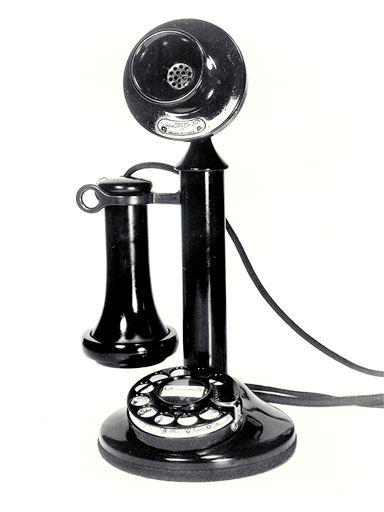
1927 - 1937
Western Electric Model 102 & 202. The first subscriber model to integrate the mouthpiece and receiver into a single handset, the 102 was introduced in 1927, followed by the 202 in 1930 (pictured here). The 202 incorporated better electronic circuitry.
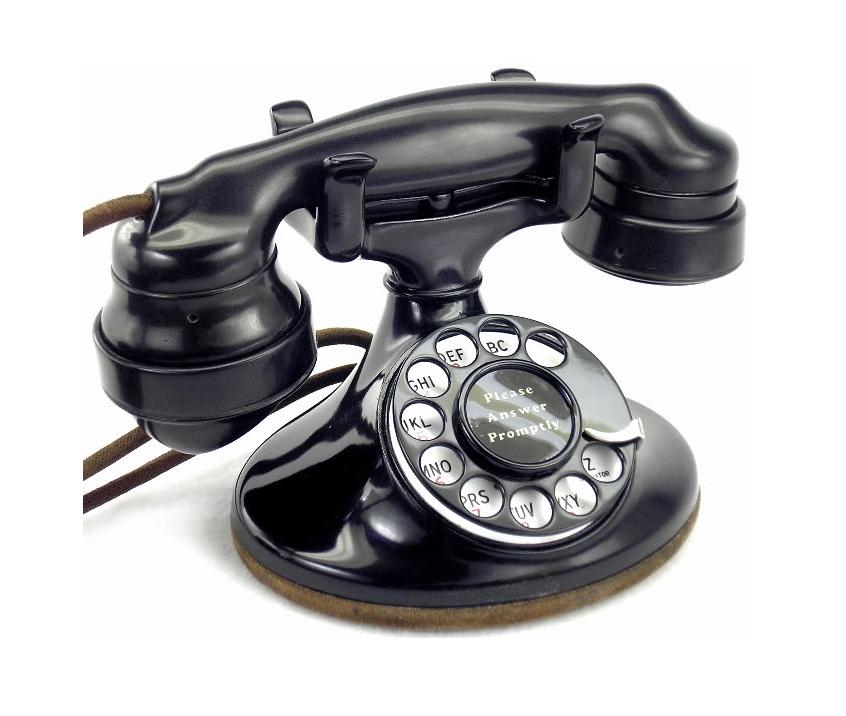
1937 - 1950s
Western Electric Model 302. Introduced in 1937, this model was the first to house the bell ringer within the base of the phone itself – a separate ringer box or subscriber set was no longer required. These were first made with zinc alloy housings and Bakelite plastic handsets, but a metal shortage during World War II led to a fully-plastic version. Some retailers refer to this model as the “Lucy phone” because it was used on the set of the popular TV sitcom I Love Lucy.
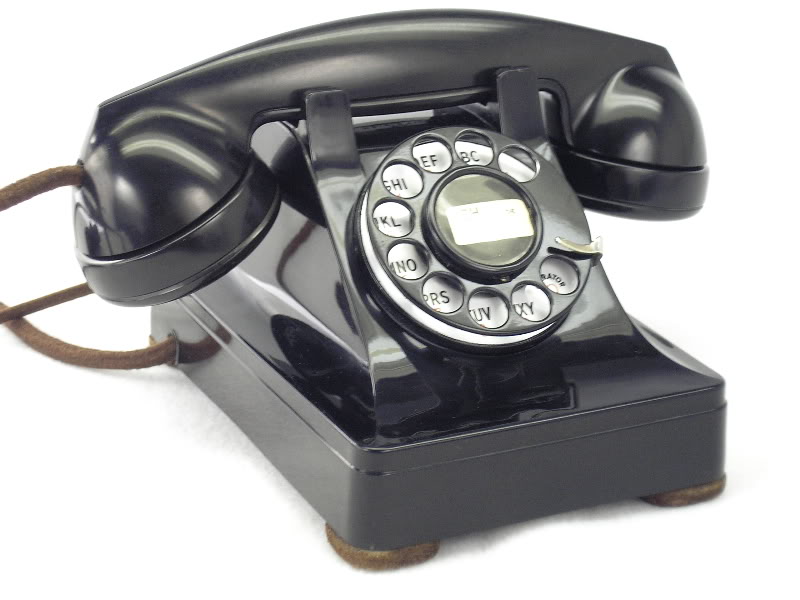
1950s - 1980s
Western Electric Model 500. This rugged model became one of the most common throughout the Bell system, beginning in 1949. In 1954, Western Electric began offering a variety of other popular colors.

Antique telephones for sale:
- Antique telephones for sale on ebay – I avoided this option because I wanted to ensure the phone I bought came from an established seller that offered at least a one-year warranty. But this could be a great option if you are learning to restore phones yourself, or want to find a cheaper price. Just make sure you understand the seller’s return policy.
- Bluetooth Ericofon – Based in California, Santiago modifies Ericofons from the 1950s into Bluetooth-enabled handsets. These will just pair with a mobile phone “as is” (no need for a Bluetooth gateway).
- Ericofon.com – Richard Rose has been carefully restoring Ericofon models for sale since 1999, and his site now includes many other antique telephone models as well. His business is based in Minnesota, his phones include a lifetime or limited warranty (depending on the age of the phone), and he also accepts returns for a full refund (minus shipping) within sixty days of purchase.
- Old Phone Shop – Wisconsin company that sells both antique phones and parts and accessories. The items for sale include detailed descriptions, and they only offer a 15-day return/exchange period.
- Oldphoneworks – Company based in Ontario, Canada – they have a great website that shows clear images and detailed descriptions of their phones for sale. They also sell lots of antique phone parts and do-it-yourself kits, and offer a one-year warranty on their antique phones.
- OldTelephones.com – This sites offers a limited stock of candlestick models for sale, but has a lot of nice images and information about candlestick models in general, along with a telephone history section.
- Vintage Swank – Retailer in Virginia that sells other vintage items in addition to refurbished telephones. They offer a full refund on returns within ten days of delivery.

